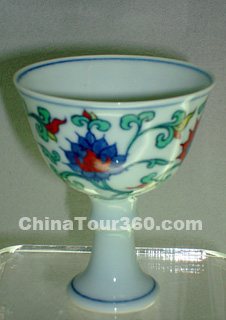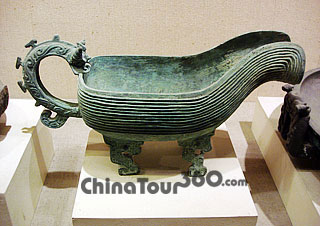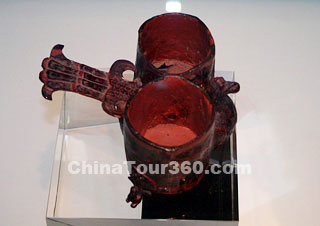Chinese drinking vessels have a long history, shared with Chinese alcohol. They not only have a practical use in storing, pouring and drinking alcohols, but also have a deep cultural and aesthetic value. From the used drinking vessels, it is also possible to determine the status of a person.
Chinese drinking vessels come in various shapes, which include cups, kettles, bowls, bottles, and jars. There are some special vessels in ancient times, such as a Zun, which is a wine storage vessel with a wide mouth, high neck and round or square base; a Jue, a vessel used for heating wine, which has three feet; a Jiao, a vessel for drinking wine with two sharp angles in the neck; a Gong, which is a vessel for the storage and drinking of wine - like a thwart horn with a round base and a cover, and shaped like an animal. According to the materials of manufacture, the drinking wares fall into pottery, chinaware, bronze, lacquer ware, jade and glass for example. In Chinese history, the use of the vessels varied with the development of etiquette within society.
Pottery vessels are the earliest examples discovered in China. They appeared during the colored pottery cultural period of the Neolithic Age (6,000 BC-2,000 BC). Due to the easy access of raw materials, the pottery drinking vessels continued in use through to the later dynasties, especially among the lower class.
|
|
During the later Xia, Shang and Western Zhou dynasties (21st Century BC-771 BC), with the increasingly wide use of bronze wares, the status of pottery vessels was gradually replaced by those made of bronze. Drinking vessels in the form of animals, such as elephant, ox, sheep and tiger, were very popular then. Moreover, the vessels varied in quality with the statues of a person.
During the Eastern Zhou, Qin, Han and Jin dynasties (770 BC-420 AD), the most popular is the brilliant and beautiful lacquer ware drinking vessels, with the most prized coming from Sichuan Province. The chinaware vessels also appeared in this period and had been through a series of developments and refinements. However, during the later Sui and Tang dynasties (581-907), gold and silver vessels took center stage for a time.
 |
| A Porcelain Drinking Vessel |
Chinaware drinking vessels appeared last but were popular for a long period. During the later Song, Yuan, Ming and Qing dynasties (960-1911), they played a dominate role. The Chinaware vessels manufactured in Jingdezhen of Jiangxi Province were quite well known. In ancient China, there were also other unique drinking vessels, which, though not as popular, held great appreciation. These included ivory, jade, glass, wood, bamboo, tin and osseous vessels.
In both the neoteric and present day, Chinese drinking vessels have also experienced rapid changes. The storage vessels of both clear spirit and white wine are bottles and jar, while beers are stored in bottles, kegs and cans. Moreover, the vessels for drinking are inclined to be the smaller cups mainly made of glass and chinaware. Nowadays factories also tend to produce some vessels that can have a dual use; both storage and drinking. In addition, various foreign wines and their drinking vessels have also entered China, and primarily to be found in the starred hotels, restaurants and bars.









